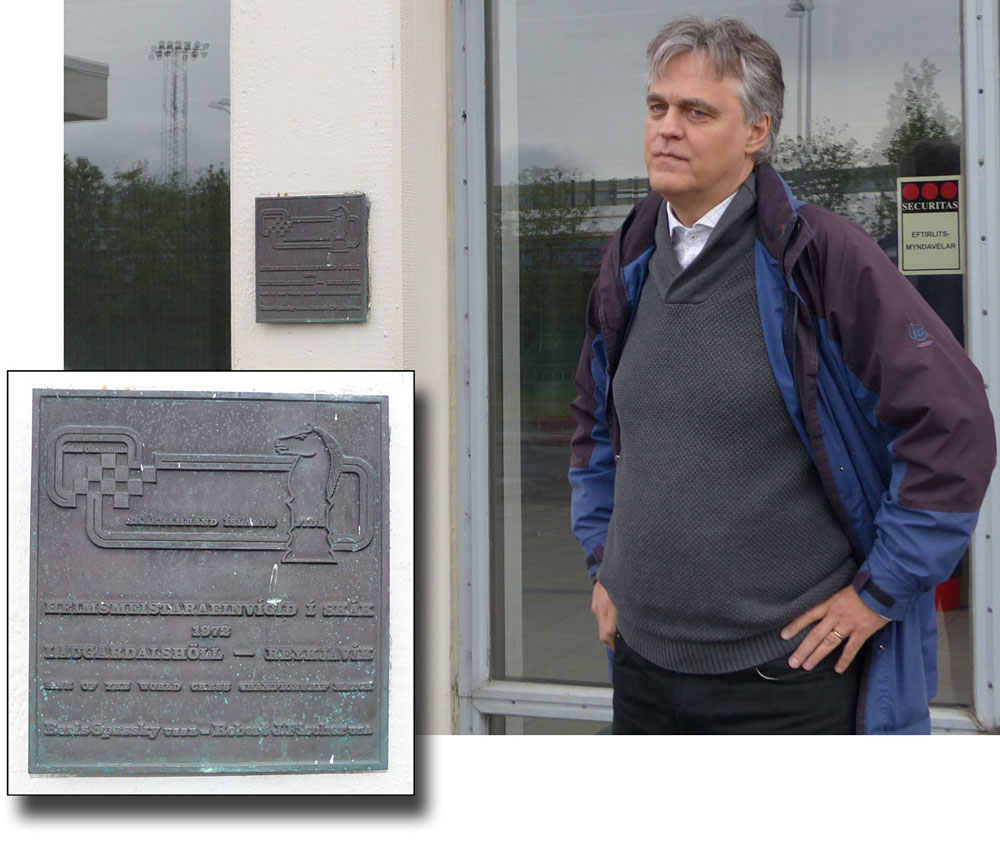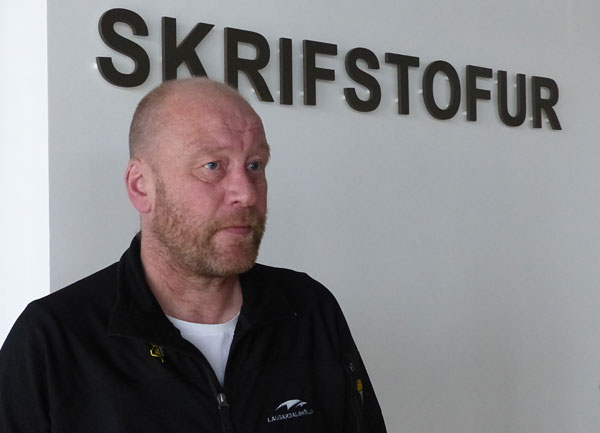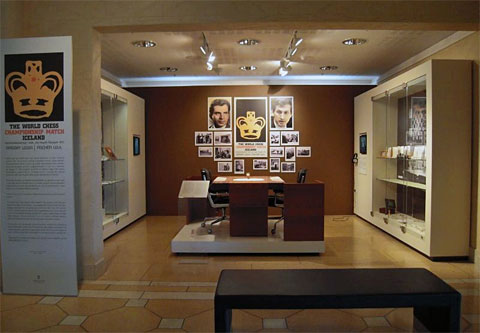


Forty-five years after the start of the premier Cold War sporting event I visited Iceland, on my first real holiday in sixteen years (readers note: I did not post a single report in the first week of June). It was mainly at the behest of my geologist wife – Iceland is arguably the most exciting geological location in the world. But of course I could not resist and met up with an old and very dear friend, Gardar Sverrisson.

Gardar (Icelandic: Garðar) was born in Reykjavík in 1959. He worked as a journalist from an early age, and his writings include two biographies, a novel and several short stories. He has been active in public life, serving as the general manager of a parliamentary group of social democrats, a member of the board of the Icelandic Human Rights Centre and for many years as the president of the national coalition of people with disabilities in Iceland. He holds degrees in political science and economics from the University of Iceland and an MFA in creative writing and literature from the University of Arizona.
In 2004, Gardar was part of a group that pressed for Bobby Fischer to be released from detention in Japan and granted asylum in Iceland. In the end he was Bobby Fischer's only friend, looking after the champion until his death in 2008. You will find an account of Fischer's final years and my friendship with Gardar in this report.
We had a wonderful afternoon with Gardar. He drove us around Reykjavik, focussing on all the places he had frequented with Bobby (I will provide further detail in a future report). The first place we visited was Laugardalshöllin, the hall in which the match took place.

Laugardalshöllin was built in 1965 as Iceland’s largest gymnasium. It was the site for innumerable sporting events and concerts – Led Zeppelin played there in 1970, Leonard Cohen in 1988, and David Bowie a decade later.

This is how Laugardalshöllin looked before the start of the Spassky-Fischer match

This is what it looks like today: Laugardalshöllin, the indoor sporting arena in Reykjavík with a capacity of 5,500 people. You can click this and most of the other pictures for a larger view.

This is the only momento of the 1972 match, a small plaque to the right of the main entrance, visible as a small dot in the previous image. It reads: "Skákamband Íslands, Heimsmeistaraeinvigid í Skák 1972, Laugardalshöll – Reykjavík. Site of the World Chess Championship match, Boris Spassky USSR - Robert J. Fischer USA"

It was late in the evening when we arrived, and the hall was closed. But Gardar had a solution: a friend inside, whom he called with a special request. Incidentally this is the side entrance that was used by Spassky and Fischer to enter and exit the hall.

Ingólfur Arnarson opened the hall for us and showed us around. He has the same name, exactly, as the first permanent settler in Iceland, in the second half of the 9th century. The island had originally been discovered by Ingólfr Arnarson – talk about coincidences...

This is the main hall as it looks today, 45 years after the Match of the Century

The stage on which the games – well, most of them – were played

In the reception area there are two cartoons of the Spassky-Fischer match
The cartoons are by Halldor Petursson, an Icelandic caricature artist who drew 18 of them for a local newspaper. In this one (click to enlarge) we see, from left to right, Jim Slater contributing to the prize fund; GM Fridrik Olafsson supporting Gudmundur Thórarinsson, President of the Icelandic Chess Federation; Fischer with pistol and spurs; above him FIDE President Max Euwe, to the right match sponsor and PR chief Chester Fox; in the middle Chief Arbiter Lothar Schmid with assistants Gudmundur Arniaugsson and Harry Golombek; Boris Spassky defending his crown, supported by seconds GM Efim Geller and Iivo Nei.
In this cartoon we see, from left to right, GMs Efim Geller, Nikolai Krogius (glasses) and Boris Spassky; Fischer taking the crown, his bodyguard Saemundur Pálsson, his second GM William Lombardy, and a cook preparing a “viking buffet”; above them Chief Arbiter Lothar Schmid (glasses) and the assistant arbiter Gudmundur Arniaugsson, below Chester Fox (trying to steal Fischer's winnings); FIDE President Max Euwe, reaching for Fischer's crown, being held by Vice President Harry Golombek; behind them Fischer's agent, Gudmundur Thórarinsson, President of the Icelandic Chess Federation, and Fridrik Olafsson.

In his office Ingólfur showed us a guest book he had found ("somewhere in the cellars"), and a bunch of leftover tickets, which cost from $5 to $11 at the time.

We examined the guest book meticulously, and there we found...
... entries by Fischer and Spassky (click to enlarge). On the left are the signatures of Vladimir Ashkenazy, André Previn, Mia Farrow and Yehudi Menuhin.

Yehudi Menuhin and Mia Farrow arriving in June 1972 for the Reykjavík Art Festival

One page on: the signatures of Max Euwe, Lothar Schmid, Nikolai Krogius, Fridrik Olafsson, Gudmundur Arniaugsson and others, all probably signed after the match.
To continue the narrative of the 1972 match: on July 6th, Fischer unexpectedly apologized to Spassky, to Max Euwe, the president of FIDE, and to the organizers for having missed the opening ceremonies. Bobby personally delivered a note of apology to Spassky’s hotel room, slipping a letter under the door. After that the match seemed again to be saved. The expectations before the start are described by Prof. Christian Hesse in A great moment in chess Part 2.
The drawing of colors finally took place on the evening of July 7th in the playing hall. Journalist Brad Darrach gives a first-hand account of the event:
At 8:45 the ceremony began. When Spassky strolled on stage, he got a big hand. Bobby was given a much fainter ovation. Spassky drifted to the chess table and inspected it calmly; he had seen it once before. Bobby, who had never seen the physical arrangements for the match, glanced quickly about the stage. The table was an angular, modern piece of heavy mahagony, rubbed to a red-gold glow. Cream-colored leather cushions had been let into the edges for the players to lean on. Bobby stared down at it for at least a minute without moving. The hall fell silent. Then Bobby's hand moved slowly toward the chessboard until at last, lovingly, he touched the white king.

The original chess table used for the Championship was prepared by cabinetmaker Ragnar Haraldsson. The chess board and pieces were made of lava stone and marble. Fischer was extremely unhappy with the mineral materials and the size of the squares. The lava board was used during the 1st, 4th, 5th and 6th games. It was replaced by a wooden board and contemporary wooden Staunton pieces for the third game, and then from the game 7–21.

The original contemporary Staunton pieces and the Garde chess clock used in the match

Today, the chess table, lava stone board, the pieces and the clock from the first game of the match belong to the National Museum of Iceland in Reykjavik.
The first game took place on July 11, 1972. Our next report will appear next Tuesday, exactly 45 years after the exciting and mysterious events of that day.
Bobby Fischer in Iceland – 45 years ago (1)
In the final week of June 1972 the chess world was in turmoil. The match between World Champion Boris Spassky and his challenger Bobby Fischer was scheduled to begin, in the Icelandic capital of Reykjavik, on July 1st. But there was no sign of Fischer. The opening ceremony took place without him, and the first game, scheduled for July 2nd, was postponed. Then finally, in the early hours of July 4th, Fischer arrived. Frederic Friedel narrates.
You might be interested to know that there is a five-hour Master Class DVD on the American Chess genius in the ChessBase Shop
|